Dieseko Group BV is the holding company of two world market leading vibratory hammer brands, being PVE and ICE. World wide Dieseko Group is active in selling and renting these high quality vibratory hammers to the foundation construction industry. In China our ICE Shanghai office is active in selling, renting and servicing the ICE brand, to many renowned companies in the offshore wind sector.
The fast-growing global offshore wind market has set new challenges for foundation companies. Wind turbine capacity grows every year, and therewith the size of the monopiles supporting these wind turbines grow as well. More power is needed to drive the piles, which creates serious underwater noise levels with conventional impact hammering. Also the growing diameters ask for larger anvils to distribute the impact from an impact hammer from the center of the anvil to the outer diameter of the monopile.
In Europe, practically each country has its own ambitions for generation renewable energy. In France, the energy company EDF appointed two offshore locations where offshore wind farms shall contribute to the renewable energy ambitions. One of these locations is called the Courseulles-sur-Mer offshore wind farm. This wind farm is located around 16 kilometres off the coast of Calvados region and will have a capacity of 450 MW with Siemens Gamesa turbines.
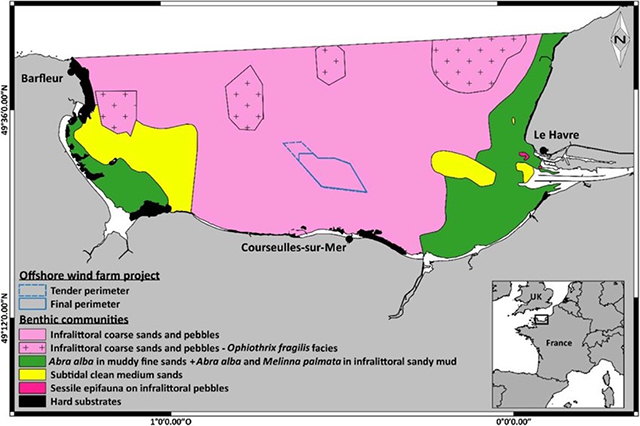
The area where the Courseulle-sur-Mer wind farm will be located is shown in the blue perimeters of above picture.
Monopiles:
For this project, 64 monopiles with a base diameter of 7.5 meters and a top diameter of 5.5 meters will be installed in the sea bed, with water depths ranging from 22 to 31 meters. The total length per monopile goes up to 60 meters and 950 tons in weight.
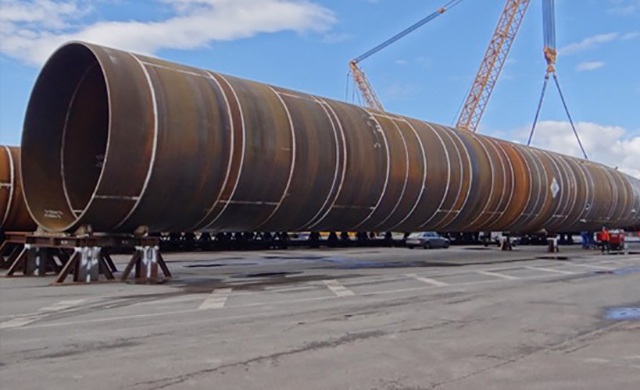
Driving the monopiles for this project into the sea bed has two difficult challenges.
First, the sea bed is rocky, which makes it difficult to drive piles to final penetration depth. Second, the underwater noise levels generated by hammering these monopiles to penetration depth would result in a catastrophic loss of sea life. Local fishermen therefore protested against the installation of the wind turbines for this reason, because they feared heavy loss of income.
To minimise impact on sea life, another method of driving the monopiles was therefore needed than conventional impact hammering.
Saipem, the awarded installation company for this project, will be required to first drill large diameter holes in the seabed, which then will be filled by compact sand and topped off by gravel.
Once all 64 holes are drilled and filled, Saipem will install the monopiles using an extra large vibratory hammer, capable of driving this size of large monopiles.
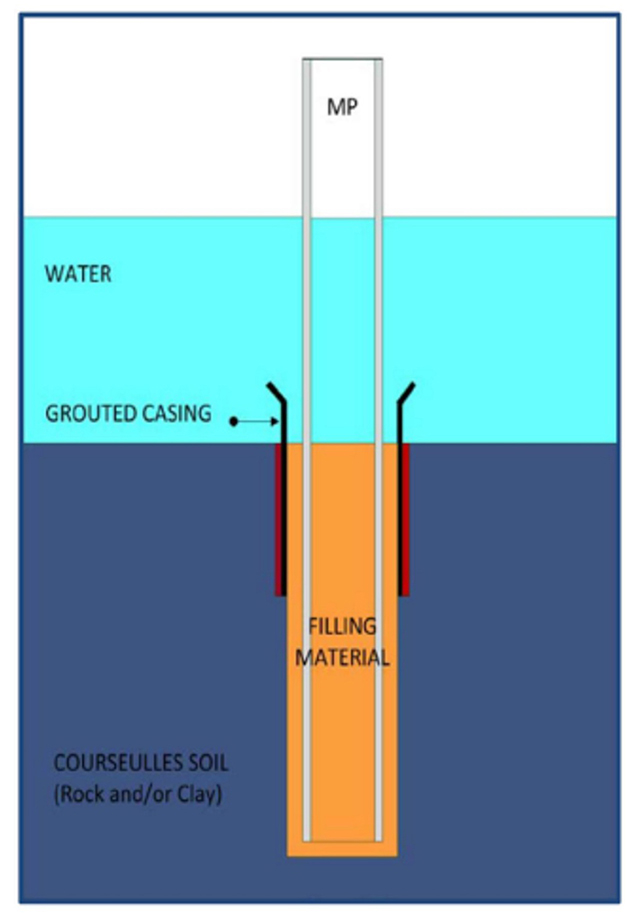
Years before the start of this project, the Dieseko Group offshore team consisting of engineers and project managers, conducted many interviews with renowned offshore installation companies, such as DEME, Saipem, Van Oord, Jan de Nul and Heerema.
All of these companies mentioned the following important aspects when installing monopiles offshore:
1) Deck space: The more efficient the vibratory hammer makes use of deck space, the more space is left on board for the monopiles, which means less mobilisations;
2) Ease of operation: the less equipment is needed to drive the monopiles, the better;
3) Availability: the equipment must work, down time is loss of production and thus loss of money;
4) Avoid pile run away: especially at locations where the top layer of the seabed consists of sand, the risk of losing a complete pile (pile runaway) is real and must be avoided.
With these main four important aspects, Dieseko designed a vibratory hammer which meets all of these four criteria, further described below.
1)Deck space:
To save deck space, Dieseko looked at ways how to stack equipment such as hydraulic hoses and hose reels. By stacking this equipment at the deck, significant deck space is saved. Further on, Dieseko looked at combining two functionalities in the hammer, hoisting and hammering, with the aim to eliminate additional cranes.
2)Ease of operation:
With the experience learned in 500NF offshore vibratory hammers, Dieseko designed an upending system for the vibratory hammer, which makes it possible to hydraulically rotate the vibratory hammer and therewith make it possible to clamp the monopile while the monopile is in horizontal position at the deck. Once clamped, the crane in which the vibratory hammer is suspended, can lift up the vibratory hammer and monopile in one single session and position the monopile in vertical position at the sea bottom. Thereafter the driving with the vibratory hammer starts.
3)Availability:
Once offshore, equipment must work when the equipment is needed. Reliability is key, therefore the Dieseko vibratory hammer only uses first class components, such as for instance Bosch Rexroth for all hydraulic components. With the vibratory hammer Dieseko also sends four licensed offshore engineers on board, and includes a container with spare parts to allow replacements of components in between installation sessions when needed. Remote monitoring equipment measures all critical parts of the power packs, hose reels and the vibratory hammer, providing data to analyse if any preventive maintenance is required to keep the hammer in excellent condition.
4)Pile run:
In soft soil conditions and when using impact hammers, pile runs can happen. In such cases, a pile disappears in the soft soil and is considered a loss. With a vibratory hammer this can be prevented, because the vibratory hammers clamps the top side of the monopile (with or without flange), preventing the pile from running away, while being driven through instable soil layers until it reaches ground layers with higher bearing capacities. This does not only prevent the loss of a monopile, it also prevents a loss in production efficiency.
The design which Dieseko made is based on proven technology of the 250 and 500NF vibratory hammers, which have already been successfully active worldwide in offshore many times, also in China.
These vibratory hammers are renowned for their performance and reliability.
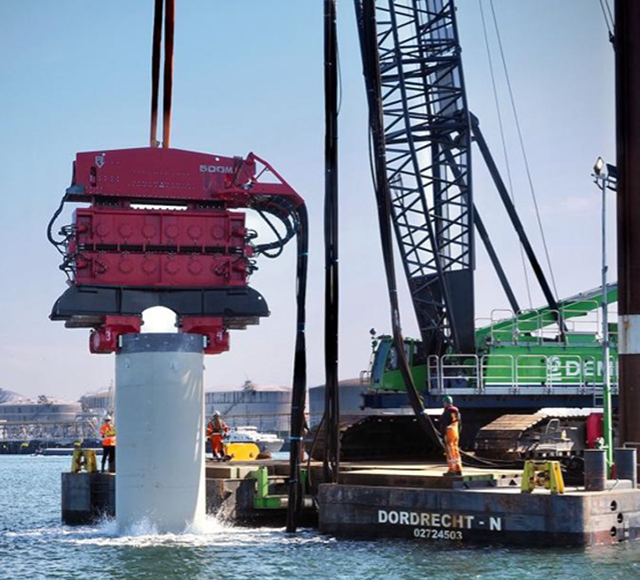
The amount of required centrifugal force for the Courseulles sur Mer project in France was calculated to be 2000 kgm, meaning four 500RF vibratory hammers would be needed simultaneously.
Dieseko designed a large supporting frame with four 500NF gear cases on top of the frame and 16 hydraulic clamps below the frame. The clamps are installed on beams that allow the clamps to slide in and outwards to fit a range of diameters.
The entire unit is suspended in an upending frame, in which the elastomers (to isolate vibrations to the crane) are mounted.
The complete vibratory hammer is called the GIANT 2000M, which can be extended to a GIANT 3000M (two additional 500NF gear cases and two additional power packs and hose reels) for even larger size monopiles. The GIANT vibratory hammer is suitable for monopile installations with top diameters up to 8 meters, typically seen already for 14 MW turbines.
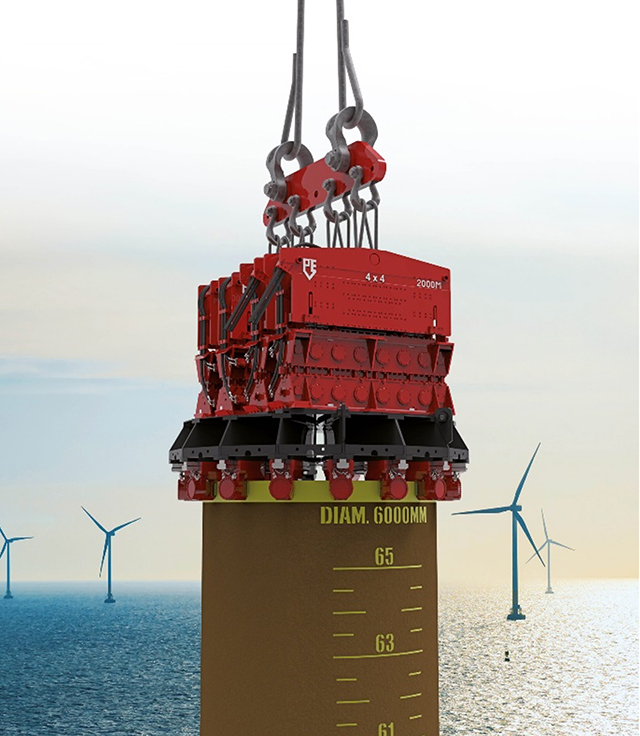
In July 2021, Saipem ordered this GIANT vibratory hammer from Dieseko Group. Various articles in the media wrote about this order (https://www.offshorewind.biz/2021/12/10/saipem-books-giant-hammer-for-french-offshore-wind-project/)
" We have been involved in this project from the early stages on and teamed up with Saipem in order to give them the best solution towards the developer of this farm Eolien Maritime France,” said Dirk Smulders, CEO of Dieseko." Given the advantages of Vibro technology for Offshore Wind applications, we see a lot of interest from developers, installation contractors and environmental organizations. This project is in line with our strategy of delivering innovative and sustainable solutions. Dieseko wants to contribute and accelerate the energy transition. Supplying this GIANT Vibratory Hammer to Saipem is the next step towards that mission and shows the confidence in this foundation method.”
Underwater noise reduction:
To minimize negative effects on sea life, noise shall need be considerably less than applicable with impact hammering, for which nowadays air bubble curtains are used to dampen out a fraction of the noise peaks generated by the impact of impact hammers on monopiles.
An external expert company specialised in noise calculations and predictions performed a detailed study for Dieseko Group. For that study, the GIANT 2000 vibratory hammer was simulated, with a driving frequency of 23.3 Hz and a centrifugal force amplitude of 42994 kN. Calculations were made for driving to 12, 23 and 35 meters penetration depth.
Main conclusion:
The average noise reduction with the Dieseko GIANT 2000M versus impact hammering amounts 15.4 dBA, which is considered to be significant.
The future:
As wind turbines grow bigger and bigger, so do the monopiles. Dieseko’s GIANT vibratory hammer solution allows for driving forces of 1500 up to 3000 kgm and for top diameters of up to 8.5 meters. With the integrated upending system the GIANT vibratory hammer allows for horizontal clamping of monopiles, lifting and driving into the sea bed.
Please contact ICE Shanghai for more detailed information.
ICE has many hammers working off the coast of China installing wind turbine foundations, including the 500NF, 250NF, 200M, and the 170NF models. Contact us today to see which size hammers suits your needs best, we can support you with driving predictions to make sure you make the most economical choice.
